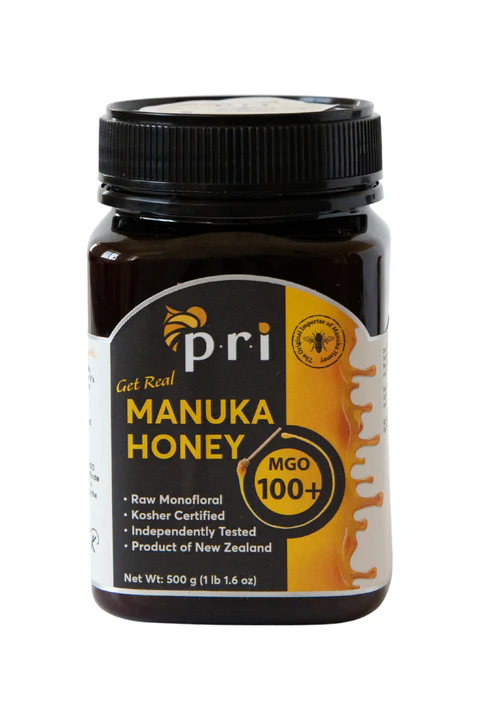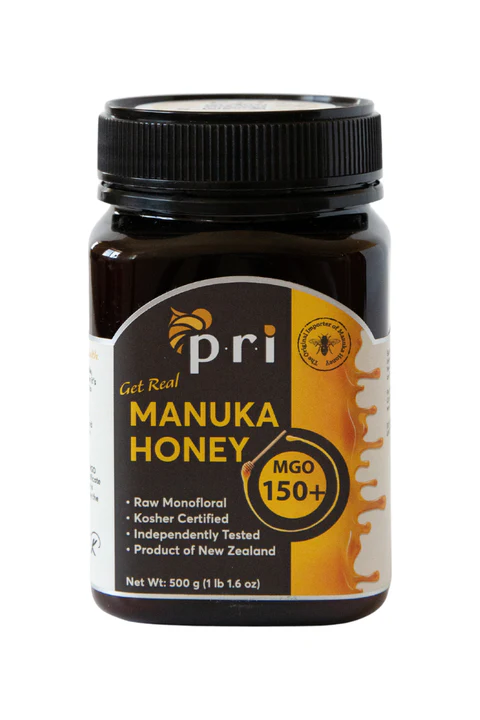Manuka Honey: Nature's healing elixir. With potent antibacterial properties, it soothes wounds and burns, accelerating the healing process. Trust in its golden goodness.
Evidence of honey used for burns & wounds can be traced back centuries. From the Sumerians of Mesopotamia to the ancient Egyptians, Greeks, and Romans. Medicinal honey use has been mentioned in the Bible & Quran and is ingrained in ancient Ayurvedic & Chinese medicine practices. Today, it is recommended by dieticians, and holistic doctors, used in hospitals, and even prescribed by some MDs!
In this article, we will tackle the following topics:
- What is the difference between raw manuka and the manuka used in hospitals (aka “medical-grade”)?
- What strength of manuka honey should you use to treat your injury?
- Why is further research so important?
- What are the different types of burns & wounds, and when should you seek medical attention?
- Why is manuka honey an effective treatment? Plus, a look at related studies.
- How to use manuka honey on burns & wounds.
The difference between raw manuka & the manuka used in hospitals:
You likely know what raw honey means: pure, unadulterated, not pasteurized or ever heated above hive temperature. You might not know that the only difference between raw manuka & the manuka used in hospitals is that the latter is typically treated with high heat or gamma radiation to “sterilize” the honey.
When it comes to the honey itself, there is no such thing as “medicinal or medical grade” honey. All real manuka honey from New Zealand has to meet strict testing & reporting requirements to leave the country. You can also find high MGO strengths in raw and sterilized honey options.
Sterilizing does kill the raw benefits, affecting the honey’s ability to provide nutrients like amino acids, vitamins & minerals, which speeds healing. However, it does not affect the MGO content, which is one of the reasons manuka honey is used in hospital settings vs. other honey types.
Since manuka has a potent antibacterial effect, why does it need to be sterilized? If you ask, we don’t think it does. Numerous clinical trials use untreated honey, and none of the participants experienced infections. Additionally, raw honey has been used for so long on so many people without adverse side effects.
The other reason it is the honey of choice in medical settings is that manuka is the only honey with high levels of methylglyoxal (MGO). MGO is the anti-bacterial/microbial/inflammatory component of manuka.
Other honeys’ properties come from peroxide activity, which is short-lived in your body and is killed off by high heat. MGO has also been found to be more effective than standard honey for most medicinal uses.
What Strength Should You Use?
The strength you choose can vary depending on the severity of what you are treating. For instance, we use a low MGO (60+) on kitchen burns and minor scrapes, which works great. More severe cases might warrant higher activity.
Even though “medical grade” is not a recognized grade or system, you’ll still see the term floating around on a lot of packaging. We’ve seen it on the strengths of MGO 400+ and up, while other brands don’t disclose what strength manuka they are using. So, even if a product is labeled medical grade, you must always look for the MGO content to know what you are getting.
At PRI, we carry grades up to 1000+ MGO, which would be great for new surgical, severe, and non-healing wounds, in addition to the treatment recommended by your doctor.
Generally speaking, honey with an MGO of 400+ and up is recommended for either external purposes or more severe internal issues like significant inflammation, injury to the stomach lining due to other digestional problems, chemotherapy, and more. If your nutritionist wants you on an anti-inflammatory diet, adding high MGO-content honey to your routine could be very helpful.
For burns & wounds, it comes down to how your injury affects your quality of life & what you can afford to incorporate into your ongoing routine. We see many success stories with lower MGO content honey, while others need to step it up.
The importance of further studies relating to manuka honey, burns & wounds.
There are centuries of data on the use of honey for medicinal purposes, along with a good number of promising current studies. It is clear we need more research on this topic, especially given what many experts are now calling the biggest threat to global health: antibiotic resistance.
Antibiotic resistance is thought to be caused by the extreme overuse of antibiotics and the ability of microorganisms like bacteria to evolve to survive. More and more organisms are becoming antibiotic resistant every day. This issue will affect everyone worldwide with higher death rates, higher costs, more hospital stays, and a wider spread of drug-resistant infections.
On the other hand, honey has never caused bacterial resistance and has been shown effective against many antibiotic-resistant organisms. Pseudomonas (the bacteria that causes pneumonia), staph infections, and MRSA are just three examples of antibiotic-resistant bacteria that manuka honey can treat.
Burns vs. Wounds
Below we will explore the different types of burns & wounds and when to seek medical attention. The practical functions of manuka honey on both types of injuries are the same, as well as how one would use honey to dress the injuries.
Different types of burns & when to seek treatment
A burn is tissue damaged by heat. Burn treatment depends on the type of burn. Here are the four types:
- First-Degree Burns or Superficial Burns are mild. These cause pain and reddening of the outer layer of the skin or epidermis. Examples of these burns would be minor cooking burns or a good sunburn. No medical treatment is needed for these types of burns.
- Second-Degree Burns or Partial Thickness Burns affect the outer layer of the skin or epidermis and the lower layer of the dermis. Examples of these burns could be from boiling water, chemical heat packs, curling irons, or friction burns. Typically, no medical treatment is needed but use your discretion.
- Third-Degree Burns or Full Thickness Burns go through the lower layer of the skin or dermis and affect deeper tissues. These burns require immediate medical attention and could be caused by prolonged exposure to scalding liquid, flames, or electric or chemical sources.
- Fourth-degree burns go deeper than third-degree burns and can affect your muscles and bones. Nerve endings are damaged or destroyed, so there is no feeling in the burn area. Seek immediate medical attention if you experience this type of burn. Prolonged flame exposure, scalding oils, and electric or chemical sources typically cause these burns.
Types of wounds & when to seek treatment:
There are two main types of wounds: penetrating and closed wounds. They each have their subsections & ranges of severity. Use discretion as to whether your injury is severe enough for medical attention.
When in doubt, get checked out!
Penetrating wounds can be:
- Surgical wounds and incisions
- Puncture wounds
- Thermal, chemical, or electric burns
- Bites and stings
- Blunt force trauma
- Abrasions
- Lacerations
- Skin tears
Closed wound examples are:
- Contusions
- Blisters
- Seroma
- Hematoma
- Crush injuries
- Ulcers
How manuka helps treat burns & wounds and related studies.
The application of honey to burns & wounds has shown the following functions:
-a reduction in inflammation
-a reduction of scar contractures
-a neutralization of free radicals
-a stimulation of processes that initiate tissue repair
-a high antibacterial effectiveness
-a stimulation of immune-strengthening processes
-creates a moist environment, promoting the regrowth of skin cells
-faster healing through the provision of necessary nutrients such as amino acids, vitamins & minerals
-a physical barrier of protection from infection
-the cleaning and deodorizing of wounds
-promotion of epithelialization
-a soothing effect which reduces pain
There are often multiple studies related to each function. You can see all of them, along with descriptive processes, here: https://www.ncbi.nlm.nih.gov/pmc/articles/PMC4158441/.
We also found this study on manuka honey for non-healing wounds interesting, though the mechanisms of healing are the same: https://www.ncbi.nlm.nih.gov/pmc/articles/PMC8386265/.
How to use honey for burns & wounds:
First, the area must be cleaned. You can do this with a diluted honey & water mixture or a saline solution.
Next, you apply the honey to the injury. You can do this either:
- Directly by simply coating the area with clean or gloved hands
- By adding it to a sterile bandage first & then applying it to the injury
- Or by mixing the honey with a carrier oil (we like castor for this purpose) to create a thinner solution that can be applied directly to the injury without needing to cover it. Note that if you do not cover the area with a bandage, make sure any clothing that goes over it is clean.
Manuka Honey 100+

$ 29.99
Our family was the first to bring distinctive, authentic, cool-processed, raw Manuka Honey to the U.S.Sourced from native Manuka trees found in New Zealand & Australia, Manuka Honey has been used for centuries by native peoples. Today doctors, naturopaths, and… Read More
PRI Manuka Honey MGO 150+

$ 34.49
Our family was the first to bring distinctive, authentic, cool-processed, raw Manuka Honey to the U.S. Sourced from native Manuka trees found in New Zealand & Australia, Manuka Honey has been used for centuries by native peoples. Today doctors, naturopaths,… Read More
Manuka Honey 600+

$ 79.99
***New Label - Same great Manuka Honey!*** Our family was the first to bring distinctive, authentic, cool-processed, raw Manuka Honey to the U.S. Sourced from native Manuka trees found in New Zealand & Australia, Manuka Honey has been used… Read More




